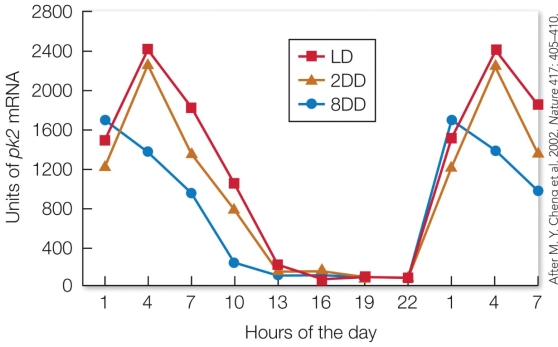Multiple Choice
Refer to the figure. This figure shows the hourly changes in the production of messenger RNA (mRNA) encoded by the PK2 gene in mice exposed to a light-dark cycles of 12 hours of light and 12 hours of darkness (LD) , complete darkness for 2 days (2DD) , and complete darkness for 8 days (8DD) . How do these results support the hypothesis that PK2 is a clock messenger?
This figure shows the hourly changes in the production of messenger RNA (mRNA) encoded by the PK2 gene in mice exposed to a light-dark cycles of 12 hours of light and 12 hours of darkness (LD) , complete darkness for 2 days (2DD) , and complete darkness for 8 days (8DD) . How do these results support the hypothesis that PK2 is a clock messenger?
A) The production of PK2 depends on the amount of daylight that is available.
B) PK2 is produced in a circadian pattern independent of light-dark cues.
C) A mutation in certain key clock genes disrupts the circadian rhythm of PK2 production.
D) Prolonged periods of darkness increase the expression of the gene that produces PK2.
Correct Answer:

Verified
Correct Answer:
Verified
Q2: John Wingfield and his coauthors made the
Q3: What is a photoperiod?<br>A) The duration of
Q4: Refer to the figure.<br><img src="https://d2lvgg3v3hfg70.cloudfront.net/TBO1022/.jpg" alt="Refer to
Q5: Refer to the figure.<br><img src="https://d2lvgg3v3hfg70.cloudfront.net/TBO1022/.jpg" alt="Refer to
Q6: In a study on golden-mantled ground squirrels
Q8: Refer to the figure.<br><img src="https://d2lvgg3v3hfg70.cloudfront.net/TBO1022/.jpg" alt="Refer to
Q9: Testosterone is apparently a very costly hormone
Q10: The occurrence of heightened chronic stress can
Q11: Apply the reproductive readiness hypothesis to explain
Q12: After a dry spring, rufous-winged sparrows in